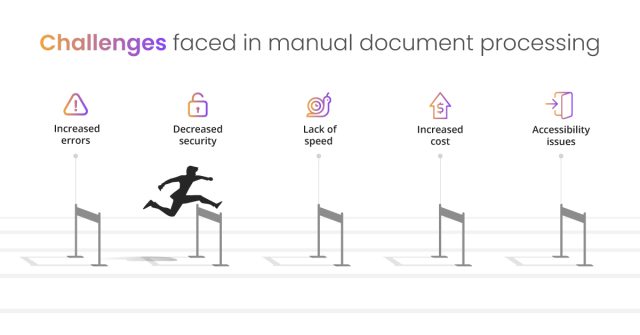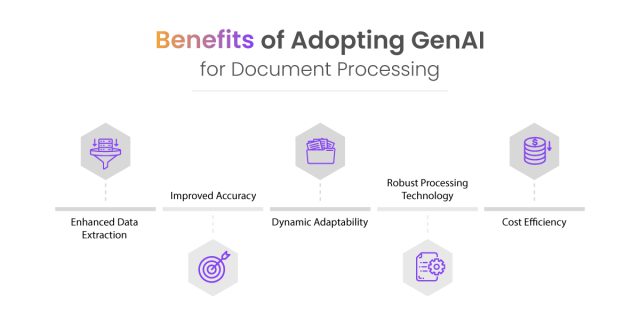Introduction:
Document processing has been steadily evolving over the last few years, along with a significant increase in its importance for several industries.
From the days of manual data entry to today’s intelligent document processing, it has been a long journey, marking the growth of this segment into a separate industry in itself.
While in the past, companies had no choice but to rely on handwritten notes and manual data extraction for their business decisions, it was time consuming and error-prone. This led to the advent of sophisticated technologies like optical character recognition (OCR) software in the late 20th century. Combining these features of OCR and utilizing deep learning, today’s intelligent document processing harnesses the power of Gen AI for detecting text from over 200 languages, recognizing handwriting, and extracting layout characteristics such as paragraphs, lines, and symbols with speed and accuracy.
In this blog, we will explore this journey, first by highlighting the importance of document processing in today’s industries and then shed some light on how the latest generation of AI technology is providing document processing with a cutting edge.
Challenges in Document Processing Evolution:
Early days of evolution
During the initial days, document processing served as a reliable business function, wherein it provided several benefits that laid the foundation for its growth. Here are some of those functions described in detail:
- Adding Clarity in Communication
Document processing led to a clear-cut understanding of the objectives, roles, and outcome requirements of several business areas by documenting functional, quality, and usability requirements. - Defining Project Management Requirements
When it came to project management, document processing helped identify project boundaries, defining what problems needed to be addressed and the constraints that had to be overcome for successful project execution. - Aiding in Business Collaboration
Document processing helped foster collaboration between different stakeholders by providing the required information to arrive at a consensus over any business decision. - Identifying Risks
Document processing provided the scope for identifying potential risks and dependencies, enabling the formulation of proactive measures. - Enabling Benchmarking
Document processing provided the basis for benchmarks for any new project requirements, ensuring deliverables met business objectives and stakeholder interests.
Challenges faced in manual document processing :
As document complexities increased, manual processing became challenging, especially in document-heavy industries like mortgages. This spurred a shift towards automating document processing for competitive advantage and improved customer experiences. *As per a recent survey published by Harvard Business Review, more than 80% of the surveyed workforce considered automation behind their increase in productivity, while 85% attributed automation as the source of better collaboration.
Given these findings and the limitations of human processing, there is an increasing need for enhanced document processing solutions.
Here are a few such limitations described further :
- Increased errors
Manual processing seemed manageable when the volume was low. However, with formats and volume changing quickly as businesses started to grow, it became increasingly difficult to bring efficiency to business processes that required document processing. - Decreased security
Securing sensitive documents and their data while being complained about by regulatory bodies became a far cry with increased volumes. - Lack of speed
When it comes to manually processing documents for data extraction, large volumes of physical documents create a scenario where a faster turnaround is almost impossible. - Increased cost
The need for physical storage and maintenance of large volumes of documents required resource deployment and increased the cost with scale-up requirements. - Accessibility issues
Accessing large volumes of documents often poses challenges both in organizing them as well as extracting data whenever required. This led to the need for a technology that can mine and extract data in an orderly manner.

Solution:
The new technology on the horizon:
Document processing evolved significantly with character recognition technology, starting in the 1920s with numeric recognition, and advancing to full character recognition in the 1950s. The introduction of digital OCR in the 1970s improved accuracy, but limitations remained, such as the inability to interpret meanings, dependency on document quality, and lack of learning from errors, highlighted the need for further improvements, sparking a new era in document processing innovation.
The advent of the AI revolution:
The limitations of OCR technology created room for further improvements and the need for a better and superior technology that would be smart enough to handle the modern-day requirements of document processing across different industry sectors.
The rapid digitization of the late 20th century and the need for easy storage and rapid retrieval of documents for handling large volumes of data gave birth to an entirely new form of document processing called intelligent document processing commonly called IDP.
The integration of artificial intelligence (AI) and machine learning (ML) gave rise to this new technology that utilizes natural language processing (NLP) and computer vision to enhance accuracy and efficiency in handling large volumes of documents.
Digital transformation with GenAI technology—unraveling the tech behind the game changer
It is undeniable that the introduction of GenAI technology has completely transformed the field of document processing.
The combination of various components of GenAI technology has created a phenomenal IDP solution such as DocVu.AI.
For example, the combination of positional OCR with the regression locator algorithm is providing cutting-edge solutions for the mortgage industry.
Let us look deeper into this by analyzing some use cases:
- Enhanced data extraction with better accuracy:
With positional OCR, lenders can identify key data points wiring mortgage documents, such as loan amounts and borrower details. The regression locator algorithm is particularly useful for unstructured data sets, wherein the IDP solution can adapt to various document layouts, ensuring accurate extraction. - Improved accuracy in handwritten text recognition:
The regression locator algorithm, when combined with advanced machine learning technology, enhances the accuracy of handwritten text recognition in mortgage documents. This is an important feature for extracting data from handwritten annotations and signatures, which traditional OCR fails to perform. - Dynamic adaptability across diverse document structures and formats:
By utilizing machine learning techniques, the regression locator algorithm learns from diverse document examples, improving the ability of IDP solutions such as DocVu.AI to recognize patterns and features across different formats. This continuous learning ability enhances extraction abilities over time. - Robust processing technology:
Advanced Gen AI technology features like a regression locator algorithm enhance the image quality of the scanned output of any OCR. It substantially reduces noise along with alignment corrections. This feature eliminates the hindrance of data extraction from a poor quality document format. - Cost-effectiveness with increased efficiency:
Positional OCR plays a key role in minimizing human intervention in document processing workflows. As a result, organizations can scale up easily without the need for proportional human resource increases. This leads to significant cost savings while having better efficiency.

Conclusion:
In document processing, where traditional OCR technology frequently falls short, generative AI’s revolutionary powers bring about a radical shift. This is further highlighted by the fact that GenAI-powered products, like DocVu.AI, automate repetitive operations and improve workflows, allowing organizations to increase productivity and accuracy. Advanced GenAI models, such as regression locator algorithms, further emphasize this. DocVu.AI helps businesses find new ways to collaborate and grow by optimizing document workflows in the mortgage sector. This helps them stay competitive in a market that is changing quickly while also saving mortgage lenders a lot of money.
Connect with DocVu.AI






